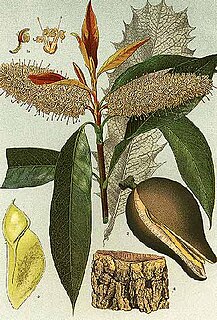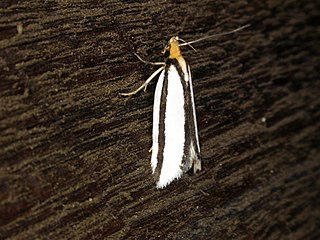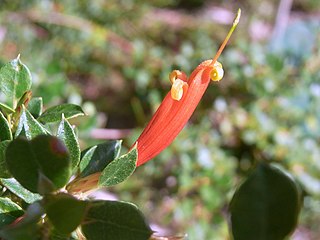
Xylomelum is a genus of six species of flowering plants, often commonly known as woody pears, in the family Proteaceae and are endemic to Australia. Plants in this genus are tall shrubs or small trees with leaves arranged in opposite pairs, relatively small flowers arranged in spike-like groups, and the fruit a woody, more or less pear-shaped follicle.

Lambertia is a genus of flowering plants, belonging to the family Proteaceae. It is endemic to Australia. The genus was named in 1798 by Sir James Edward Smith in honour of English botanist Aylmer Bourke Lambert.

Lambertia multiflora, commonly known as many-flowered honeysuckle, is a multi-stemmed shrub which is endemic to the south-west of Western Australia. It grows to between 0.5 and 2.5 metres high and flowers from winter to summer.

Lambertia ericifolia , commonly known as heath-leaved honeysuckle, is a shrub which is endemic to the south-west of Western Australia. It grow up to 5 metres high and has orange to red flowers which appear from spring to autumn.
Honeysuckles are vines in the genus Lonicera

Xylorycta is a genus of moths of the family Xyloryctidae. Xylorycta species are found in Africa and Australia and are strongly associated with the plant family Proteaceae, being found on Hakea, Lambertia, Grevillea, Leptospermum, Macadamia, Oreocallis, Persoonia and Telopea. The larvae of some species bore into stems or branches, or the flower spikes of Banksia, but most live in a silk gallery spun in the foliage.

Lambertia formosa, commonly known as mountain devil, is a shrub of the family Proteaceae, endemic to New South Wales, Australia. First described in 1798 by English botanist James Edward Smith, it is the type species of the small genus Lambertia. It is generally found in heathland or open forest, growing in sandstone-based soils. It grows as a multistemmed shrub to around 2 m (7 ft) with a woody base known as a lignotuber, from which it regrows after bushfire. It has stiff narrow leaves, and the pink to red flowerheads, made up of seven individual tubular flowers, generally appear in spring and summer. It gains its common name from the horned woody follicles, which were used to make small devil-figures.

Lambertia inermis, Noongar chittick, is a shrub which is endemic to south-west Western Australia. It grows to 6 metres high and flowers from spring to winter. A more complete description is given in Florabase and Australian Flora online.
Thaumastochloa is a genus of Australian, Papuasian, and Indonesian plants in the grass family.

Dyckia rariflora is a plant species in the genus Dyckia endemic to the State of Minas Gerais in Brazil.

Lambertia uniflora is a shrub in the family Proteaceae. Endemic to the moist south-west corner of Western Australia, it grows to 3 metres in height. Single axillary or terminal flowers appear between October and January in the species' native range. These are orange or red with a yellow or yellow-green limb. This species first appeared in the scientific literature in 1810, authored by the prolific Scottish botanist, Robert Brown.
Honey flower is a common name for several plants and may refer to:

Lambertia orbifolia, commonly known as the roundleaf honeysuckle, is a shrub or small tree that is endemic to the south-west of Western Australia. It has more or less circular leaves and groups of between four and six orange-red flowers.

Lambertia echinata, commonly known as prickly honeysuckle, is a shrub which is endemic to the south-west of Western Australia.

Lambertia ilicifolia, commonly known as the holly-leaved honeysuckle, is a shrub which is endemic to south-west Western Australia.
Lambertia fairallii, commonly known as Fairall's honeysuckle, is a shrub which is endemic to the south-west of Western Australia.

Xylorycta strigata, the banksia web-covering borer, is a moth in the family Xyloryctidae. It was described by John Lewin in 1805. It is found in Australia, where it has been recorded from New South Wales, Queensland and South Australia.

Rhynchospora rariflora, commonly called fewflower beaksedge, is a species of flowering plant in the sedge family (Cyperaceae). It is native to North America, where it is found in the southeastern United States, Mexico, Belize, Honduras, Nicaragua, and the West Indies. Its typical natural habitat is sandy or peaty areas, in wet savannas, seeps, and bogs.














